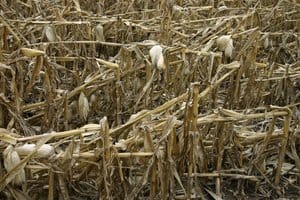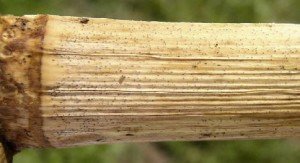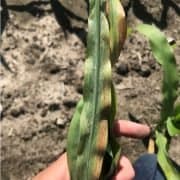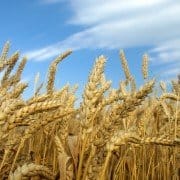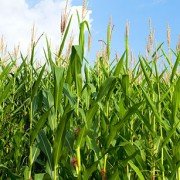Stalk rots in corn
The distribution and prevalence of stalk rot diseases vary from year to year. However, the diseases are present in most years even though it may be at low levels. The majority of stalk rot damage in Ontario is caused by three fungi, Anthracnose, Gibberella and Fusarium. However, Diplodia and Pythium have also been observed.
Although these fungi cause different symptoms, their ultimate effect on the corn plant is the same. They reduce grain fill, stalk integrity, and accelerate senescence. The severity of this damage increases when the crop is under stress.
Scouting
The Push Test:
- Randomly select 20 plants from 5 different areas of the field
- Push the top portion of the plant 6-8 inches to the side
- If the plant becomes lodged, it has a stalk rot
- Record the number of lodged plants
The Pinch Test:
- Randomly select 20 plants from 5 different areas of the field
- Remove the lower leaves and pinch the stalk just above the brace roots
- If the stalk easily collapses, it has a stalk rot
- Record the number of rotted stalks
If 10-15% of the plants are lodged or rotted, harvest the crop early. The cost of extra drying will be offset by less corn being left out in the field.
Management Strategies
At this time of year, the only thing a grower can do to minimize yield loss from stalk rots is to harvest infected fields prior to healthier fields. The following management tactics can be used to assist in preventing stalk rots from developing in the future:
- Plant hybrids that have good resistance or tolerance to leaf diseases and stalk rots
- Manage insects such as European corn borer
- Control weeds
- Plant appropriate populations for the soil type/hybrid
- Balanced N and K fertility program
- Crop rotation
- Tillage of crop residue
| Disease | External stalk symptom | Internal stalk symptom | Environment |
|---|---|---|---|
| Gibberella | Small black spots, easy to scrape off | Shredded with a pink to red colour pith | Warm, wet weather during & after pollination |
| Fusarium | Light brown to black lesions near the nodes | White to salmon pink fungal growth | Warm, dry weather, stresses after pollination |
| Diplodia | Small black spots, hard to remove | Disintegrated pith | Warm, wet weather 2-3 weeks after pollination |
| Anthracnose | Large, shiny, dark brown to black streaks | Discoloured black and rotted pith | Any stress following pollination |
| Pythium | No visible signs | A “wet rot” at the base of the stalk | Wet weather |
Contact us
For more information contact one of our Agronomy Solution Specialists or any local Thompsons branch.
Chris Hunt, CCA
Agronomy Solutions Specialist
Phone: 519-676-5411, Ext. 20478 | Cell: 519-365-3593
Jevin Vyn
Agronomy Solutions Specialist
Phone: 519-676-5411, Ext. 20303 | Cell: 519-401-2120
Mike Wilson
Advanced Agronomy Solutions Manager
Phone: 519-676-5411, Ext. 20480 | Cell: 519-809-0284
References: pioneer.com; omafra.gov.on.ca


